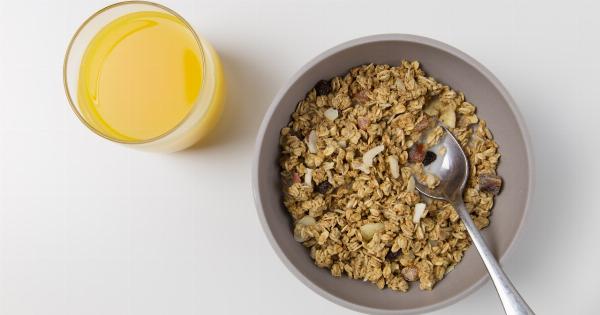Fiber is an essential nutrient that supports a healthy digestive system, weight management, and cardiovascular health. Despite its importance, many people do not consume enough fiber in their diets.
The recommended daily fiber intake is 25 grams for women and 38 grams for men. If you’re struggling to meet your daily fiber needs, here are 30 ways to boost your fiber intake.
1. Start Your Day with Fiber
Beginning your day with a high-fiber breakfast can help you meet your daily fiber needs. Opt for whole-grain cereals, oatmeal, or whole-grain bread. One slice of whole-grain bread can provide up to 3 grams of fiber.
2. Snack on Fruits and Vegetables
Fruits and vegetables are excellent sources of fiber. They also provide other essential vitamins and minerals. Snack on apples, bananas, berries, carrots, cucumbers, and other fiber-rich produce throughout the day to increase your fiber intake.
3. Choose Whole Grains
Substitute refined grains with whole grains to increase your fiber intake. Whole grain bread, pasta, rice, and crackers are great choices for high-fiber meals.
One cup of whole wheat pasta provides 6 grams of fiber, while a cup of white pasta only provides 2 grams.
4. Add Beans to Your Meals
Beans are an excellent source of fiber, protein, and other essential nutrients. Add beans to your meals to increase your fiber intake. Kidney beans, black beans, lentils, and chickpeas are all great choices for high-fiber meals.
5. Nuts and Seeds
Nuts and seeds are packed with fiber, healthy fats, and other important nutrients. Snack on almonds, walnuts, chia seeds, and pumpkin seeds to increase your fiber intake.
6. Add Berries to Your Meals
Berries are rich in fiber and antioxidants. Add them to your meals to increase your fiber intake. Blueberries, raspberries, strawberries, and blackberries are all excellent choices for high-fiber meals.
7. Choose High-Fiber Snacks
Snacking on high-fiber foods throughout the day can help you meet your daily fiber needs. Some great high-fiber snacks include popcorn, edamame, and roasted chickpeas.
8. Add Vegetables to Your Meals
Vegetables are packed with fiber and other important nutrients. Make sure to include them in your meals to meet your daily fiber needs. Broccoli, brussels sprouts, kale, and spinach are all great choices for high-fiber meals.
9. Increase Your Water Intake
Drinking more water can help fiber move through your digestive system and prevent constipation. Aim for at least eight glasses of water a day to support your digestive health.
10. Try Fermented Foods
Fermented foods such as yogurt, kimchi, and sauerkraut contain probiotics that support digestive health. They also contain fiber that can help regulate bowel movements.
11. Eat More Whole Fruits
Whole fruits contain more fiber than fruit juice. Opt for whole fruits such as apples, pears, and oranges to increase your fiber intake.
12. Choose High-Fiber Cereals
Many cereals are high in fiber. Opt for cereals that have at least 5 grams of fiber per serving to increase your fiber intake. Bran flakes, shredded wheat, and oatmeal are all great choices for high-fiber breakfasts.
13. Add Flaxseed to Your Meals
Flaxseeds are high in fiber and contain essential omega-3 fatty acids. Add flaxseed to your meals by sprinkling them onto salads, oatmeal, or yogurt.
14. Replace Meat with Plant-Based Proteins
Plant-based proteins such as tofu, tempeh, and seitan are excellent sources of fiber. Replace meat with these plant-based proteins to increase your fiber intake.
15. Snack on Hummus
Hummus is made from chickpeas and is an excellent source of fiber. Snack on hummus with carrot sticks or whole-grain crackers to increase your fiber intake.
16. Cook with Whole Grain Flour
Replace white flour with whole grain flour when cooking. Whole grain flour contains more fiber and nutrients than white flour and can help boost your fiber intake.
17. Add Avocado to Your Meals
Avocado is an excellent source of fiber and healthy fats. Add avocado to your salads, sandwiches, or smoothies to increase your fiber intake.
18. Choose High Fiber Breads
Opt for high fiber breads such as whole wheat, rye, or sourdough to increase your fiber intake. These breads contain more fiber than white bread and can help support healthy digestion.
19. Switch to Brown Rice
Brown rice contains more fiber and nutrients than white rice. Switch to brown rice to increase your fiber intake and support healthy digestion.
20. Add Whole Grain Pasta to Your Meals
Whole grain pasta contains more fiber than white pasta. Add whole grain pasta to your meals to increase your fiber intake and support healthy digestion.
21. Choose High-Fiber Tortillas
Opt for high fiber tortillas made from whole grains to increase your fiber intake. Use these tortillas to wrap up your favorite veggies and proteins for a high fiber meal.
22. Eat More Artichokes
Artichokes are packed with fiber and other important nutrients. Eat more artichokes by grilling them, adding them to salads, or roasting them with garlic and olive oil.
23. Add Lentils to Your Meals
Lentils are an excellent source of fiber and protein. Add lentils to soups, salads, or stews to increase your fiber intake and support healthy digestion.
24. Try Quinoa
Quinoa is a high-fiber grain that is also a great source of protein. Use quinoa in place of rice or other grains to increase your fiber intake and support healthy digestion.
25. Add Sweet Potatoes to Your Meals
Sweet potatoes are an excellent source of fiber and vitamins. Add sweet potatoes to your meals by roasting them, mashing them, or making sweet potato fries.
26. Snack on Popcorn
Popcorn can be a healthy high-fiber snack. Opt for air-popped popcorn or popcorn that is lightly seasoned to increase your fiber intake.
27. Add Broccoli to Your Meals
Broccoli is packed with fiber and other essential nutrients. Add broccoli to your meals by roasting it, steaming it or adding it to stir-fries.
28. Add Chia Seeds to Your Meals
Chia seeds are an excellent source of fiber and other important nutrients. Add chia seeds to your meals by sprinkling them onto oatmeal, yogurt, or smoothies.
29. Eat More Brussel Sprouts
Brussel sprouts are packed with fiber and vitamins. Eat more Brussel sprouts by roasting them, sautéing them, or adding them to stir-fries.
30. Choose High-Fiber Crackers
Opt for high-fiber crackers such as whole-grain or seeded varieties to increase your fiber intake. These crackers make a great snack on their own or paired with hummus or cheese.




























